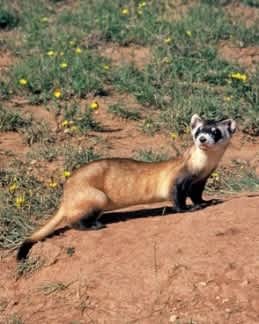Happy 15th, 20th and 30th Anniversary to Arizona’s Black-footed Ferrets
OutdoorHub 09.27.11

Phoenix, AZ — Arizona’s endangered black-footed ferret population is celebrating a triple anniversary: the 30th anniversary of the discovery of the last black-footed ferrets, a species that was thought to be extinct; the 20th anniversary of the Phoenix Zoo’s breeding program to help recover the species in Arizona; and, the 15th anniversary of Arizona’s Aubrey Valley being selected as a reintroduction site.
In the late 1970s, the species was thought to be extinct until a small colony of approximately 120 ferrets was discovered near Meeteetse, Wyo. on Sept. 26, 1981. Disease outbreaks reduced this population to 18 individuals, which were captured in 1985 to begin a captive breeding program to save the species.
As one of only six facilities in the world that participate in the species’ breeding program, the Phoenix Zoo has produced more than 400 ferrets since it opened its first breeding facility 20 years ago. In 2010, the zoo opened the new Arthur L. “Bud” and Elaine V. Johnson Black-Footed Ferret Breeding Center to better enable them to continue their successful breeding program.
“We at the Phoenix Zoo are proud to celebrate 20 years of commitment to the black-footed ferret breeding program,” said Phoenix Zoo President and CEO of the Arizona Zoological Society Bert Castro. We are one of only six facilities in the world that breed black-footed ferrets, and we take this responsibility very seriously.”
The descendants of the original 18 ferrets have now been introduced into 19 reintroduction sites, including the Aubrey Valley outside of Seligman, Ariz. Before reintroduction, the last black-footed ferret in Arizona was found in 1931 in an area between Williams and Flagstaff.
Black-footed ferret surveys conducted last fall by the Arizona Game and Fish Department showed a record 96 animals in the Arizona population. Because not all ferrets were captured and included in the survey count, the number of animals identified during the survey is a minimum population estimate, and the actual population could be larger.
“These milestones are significant accomplishments for the reintroduction program and demonstrate what successful cooperation can do for wildlife conservation,” says Larry Voyles, director of the Arizona Game and Fish Department. “With continued help from the Phoenix Zoo, U.S. Fish and Wildlife Service and funding support from the Heritage Fund, we will continue to work towards a full recovery for the species.”
Not only was the number of ferrets identified a record high for Arizona’s population, but it also exceeded the state’s objective that needs to be met in order for the species to be “downlisted” from endangered to threatened on the endangered species list. “Downlisting” means that the species has recovered to a point where it is no longer in danger of extinction. All states with black-footed ferret populations are given state-specific recovery guidelines that lead to a larger national recovery effort. The national recovery guidelines must be met before “downlisting” the species can be considered.
“The effort to bring the ferret back from oblivion can be described as truly heroic,” says Steve Spangle, Arizona field supervisor for the Fish and Wildlife Service. “There are a couple of lessons we must never forget: That we must remain vigilant so that other species don’t decline to such perilous levels; and that such a conservation success can only be accomplished when many entities work in partnership.”
Today, biologists estimate there are a minimum of 800 to 1,000 individual ferrets living in the wild.
While they resemble domestic pet ferrets, black-footed ferrets are a different species and are the only ferret native to North America. They can grow to be up to 2 feet long and can weigh up to 2 ½ pounds. One ferret can give birth to three to five kits each year.
The Arizona black-footed ferret reintroduction program is a joint effort of the Arizona Game and Fish Department, U.S. Fish and Wildlife Service, the Phoenix Zoo, Hualapai Nation, Navajo Nation, Arizona State Land Department and the Cholla Cattle Company.
Note to media: Photos and video of black-footed ferrets and interviews with those involved in the reintroduction effort are available by calling Game and Fish Public Information Officer Lynda Lambert at (623) 236-7203.

